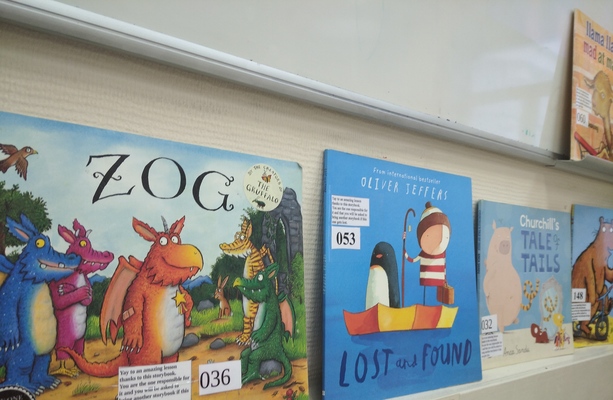
Writing this kind of a post about songs was a lot of fun. Here’s hoping to the same results with stories.
Storytelling (a definition for the purpose of this post): story-everything in class: telling stories, reading stories, listening to stories, writing stories, making-up stories, watching stories…
All the reasons to use stories in class when you teach children…
- Stories, storybooks, traditional stories are a part of the child’s world
- Stories help children learn about the world and the concepts
- They also provide models of behaviour
- They introduce children to other cultures
- Telling stories and listening to stories is a social event
- They help to develop focus and concentration
- They can be a starting point to developing learning strategies such as predicting or making hypothesis
- They expose children to different illustrations and they help to develop visual literacy
- They help develop imagination
- They help to develop kids’ memory
- Stories help children to know the sounds, rhymes and this way to develop early literacy skills
- Working with stories helps children learn about the value of books
- They help children learn about the real and the imaginary world
- Stories help faciliate interaction between adults and children
- Children who read and listen to stories find it easier to understand other people
- Kids who read stories are likely to have higher confidence levels
- Stories are a natural way of teaching children
- Stories help children relax
- Stories help children understand their own feelings
- Reading and stories can develop critical thinking skills
- Storytelling and story reading can be a source of fun and pleasure
All the reasons to use stories in class because you teach a foreign language…
- They create the context for the language
- They help to build and develop the vocabulary
- They can be used to introduce the langauge
- They can be used to practise the langauge
- They can be used to revise the language
- They help develop listening skills
- They expose the children both to dialogue and to narrative
- Listening to stories is the first step to producing the language
- They help develop literacy skills
- Stories are a wonderful opportunity for integrating skills ie reading with listening or speaking with writing.
- The stories created specifically for the EFL / ESL context have the graded language and they are built closely around the vocabulary and structures that they are already familiar with
- Traditional stories have the advantage of being familiar to the children already and this will make their reception in a foreign language much easier
- Storybooks are a source of the beautiful and natural language that can be made accessible to children. Some of them might be known to children (for example Gruffalo or The Very Hungry Caterpillar) and this will make the L2 version more easily understood and easier to use
- Visuals accompanying the stories can also be used as a resource to introduce and to practise the langauge
- They are an intergral part of the Young Learners Exam so using stories in class from early on will be contributing to preparing students for them
- They can help connect studying English at school and studying English at home
- They can motivate the children to learn the language
- Using stories in class can encourage children to read for pleasure
- Storytelling can be used as a classroom management tool as they are natural settlers
- Some of the concepts in stories can be used to manage children’s behaviour in the EFL/ESL classroom ie ‘Boris goes to school’ is a story about making friends
- Telling stories or reading stories can be an introduction or a follow-up to song lessons or craft lessons
- Many stories have a set of structures and that makes them easier for the EFL/ESL students to learn
- A story is usually used in more than one lesson. This repetition is also beneficial for the students as they can get more and more involved in the retelling or the re-reading of the stories
- Telling stories can be an introduction to role-plays and drama activities
- Even the lower level students can be encouraged to create stories. They will use their ideas based on the vocabulary they have (Wright)
- Storytelling activities appeal to children with different intelligences and learning styles (Read)
- Stories can be used to supplement the coursebook
- Or they can be used as the basis for a curriculum
- Reading and listening to stories can help with pronunciation in L2, too.
- Stories encourage the kids to contribute ideas and to express themselves
Have I forgotten anything? I must have. Although 50 is not a bad number to start with. More later…
Happy teaching!
Bibliography
I will give myself a permission to be slightly reckless about referencing everyone since it is not a very serious research article. While preparing this post, I have consulted:
Sandie Mourao and Gail Ellis (2020), Teaching English to Pre-primary children, Delta Teacher Development Series
Opal Dunn (2012), Introducing English to Young Children: Spoken Language, Collins
Reading and storytelling with babies and children, raisingchildren.net.au
Why is storytelling important to children? BBC Teach
Why are stories important for children? The Writers Bureau
Why is reading so important for children? High-Speed Training
11 Reasons Why Reading is Important for Children, EdArabia
Andrew Wright ( ), Creating Stories with Children, Resource Book for Teachers
Carol Read (2007), 500 Activities for Primary Classroom, Macmillan
The importance of storytelling in the EFL classroom, The EFL Academy
Some Tips on Using Storytelling in the EFL Classroom, EFL Magazine
Karen Saxby, Using Pictures and Stories in the EFL Classroom, HLT Mag
Teaching English to Young Learners Using Stories: The Ultimate Guide, The ELT Guide
How to use storytelling in language teaching, Yur Topic